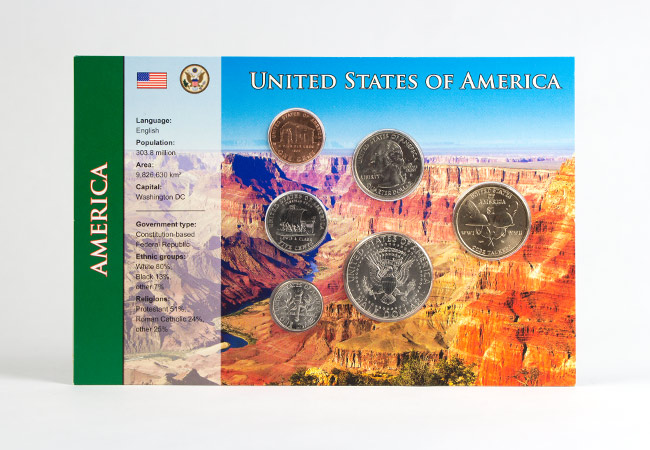Posts Tagged ‘Rare Coins’
The UK’s Top 10 Rarest Coins in Circulation
Which coins should you be looking out for in your change?
We’ve taken a look at the mintage figures for UK coins to find out which ones are the rarest in circulation...
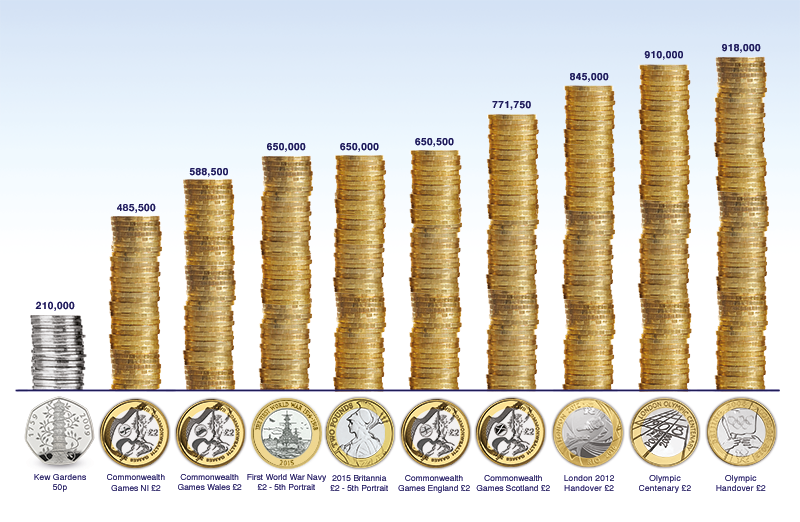
What you might be surprised by is that on our top 10 list, just 1 out of the 10 coins is a 50p!
The rarest UK coin currently in circulation is the Kew Gardens 50p, but the 9 rarest coins after that are actually £2s.
Whilst 50p coins are very popular amongst collectors at the moment, it’s certainly worth noting that it is in fact the £2 coins which you should be keeping your eyes peeled for, as some of the ones you can find in your change are very rare.
Other rare coins to look out for
Of course, this doesn’t take into account the rare error coins that have been found in circulation, such as:
- 2015 inverted effigy Britannia £2
- Olympic Aquatics 50p error
- Bronze 20p error
- Silver 2p error
- Undated 20p mule
Whilst exact mintage figures for these error coins may be unknown, we can assume that they could each be rare enough to find themselves near the top of the list.
A-Z of Great Britain 10p coins

It’s also worth noting that whilst mintage figures for the individual designs haven’t been released, if we assume that each A-Z of Great Britain 10p has been struck in equal quantities, then there would be approximately 281,000 of each design.
This would put each A-Z 10p design in equal second place on the list of the top 10 rarest coins in circulation!
What about the coins no longer in circulation?
Currently the Kew Gardens 50p is the rarest coin in circulation, but did you know that it isn’t actually the UK’s rarest 50p?
This title goes to the 1992/93 UK EC Presidency 50p, with a mintage of just 109,000 – almost half of the Kew Gardens!
In 1997, 50p coins were redesigned in the smaller specification and this coin was demonetised, meaning it is no longer in circulation.
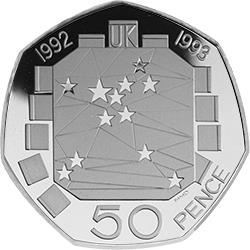
The same can be said of the 1989 Claim of Right £2, which was demonetized in 1997 when the bi-metallic £2 coin was introduced.
This coin has a mintage of 381,400 which makes it the rarest UK £2 and would put it in second place on the list if it were still in circulation.
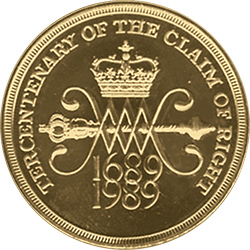
Are you lucky enough to have any of the top 10 rarest coins in your collection? Or perhaps you’ve even been lucky enough to get your hands on the pre-1997 coins listed above. Let us know in the comments below!
If you’re interested in coin collecting, our Change Checker web app is completely free to use and allows users to:
– Find and identify the coins in their pocket
– Collect and track the coins they have
– Swap their spare coins with other Change Checkers

Sign up today at: www.changechecker.org/app
America’s most infamous coins…
Every coin tells a story. But few more than America’s eight most notorious coins…
The U.S. collectible coin market can be an absolute minefield and is one of the most competitive coin collecting markets in the world.
Some of the most collectible coins date back to the 1800’s and are extremely famous. Let me tell you why…
Indian Head Penny (1859-1909)

The Indian Head Penny is famous for celebrating Native Americans, but it actually doesn’t show a Native American.
According to legend, designer James B. Longacre used a portrait of his 12 year old daughter, Sarah, wearing a headdress. It is, however, more likely that the portrait was based on a classical Greco-Roman statue Venus Accroupie (Crouching Venus).
Either way, the ‘Indian’ is not a Native American! The obverse features the head of Lady Liberty wearing a headdress, while the reverse depicts a wreath as well as the words ‘One Cent’ and a shield in the middle at the top of the coin.
Morgan Silver Dollar (1878-1921)
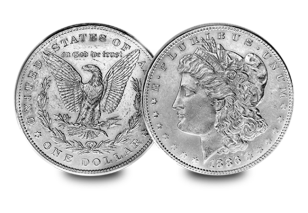
For the new silver dollar, designer George T. Morgan decided to portray Liberty as a goddess, inspired by Philadelphian school teacher, Anna Williams who had a fair complexion, Grecian nose and golden hair. Morgan eventually persuaded Anna Williams to sit as the model for Liberty for the obverse of the Morgan Silver Dollar.
In 1878 artists’ models were considered immoral, therefore, Morgan publicly stated that the model was a statue in a Philadelphia museum. Word soon leaked out, however, and it is rumoured that Williams was fired from her teaching job!
‘No Cents’ Liberty Head Nickel (1883)
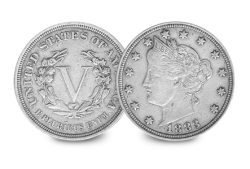
When the new Liberty Head Nickel was issued in 1883, the denomination was nowhere to be seen, instead a large ‘V’ (Roman ‘5’) was on the reverse.
The coins were the size of the $5 gold coin in circulation at the time which created an opportunity for unscrupulous crooks who came up with a cunning plan to pass them off as $5 by gold plating the new nickels and cutting reeds into the edge by hand. The U.S Mint soon became aware and within a few weeks the design was changed to include the word ‘Cents’ under the ‘V’. The ‘No Cents’ coins are also known as ‘Racketeer’ Nickels.
Lincoln Penny (1909)

Designer Victor David Brenner added his ‘VDB’ initials to the new Lincoln Penny design in 1909 which was issued to commemorate the 100th anniversary of Abraham Lincoln’s birth.
While the public generally loved the Lincoln cent when it was first released, they didn’t like the prominence of Brenner’s initials. The U.S. Mint quickly removed the initials as it appeared as though Brenner was either boasting or advertising. This was the first cent to feature Abraham Lincoln’s motto ‘In God we trust’ on the obverse.
Morgan Dollar (1921)
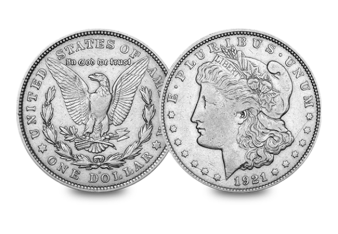
When notorious outlaws Bonnie and Clyde were shot and killed by police in 1934, a 1921 Silver Morgan Dollar was recovered from the jacket of Clyde Barrow among other possessions. The outlaw lovers were believed to have committed 13 robberies among other felonies between 1932 and 1934.
The hunt for the duo captured the nation’s imagination during the Great Depression and their fame was heightened by their practice of leaving glamourous photos of themselves at crime scenes.
Even more so now, the 1921 coin is forever associated with Bonnie and Clyde.
Roosevelt Dime (1946)

In 1945 plans were quickly laid for the introduction of a new coin to honour Roosevelt after his passing. The task was assigned to John Ray Sinnock and coinage began in 1946. Controversy soon arose because sculptor Selma Burke claimed that Sinnock had stolen her design without giving her credit, however Sinnock strongly denied this.
In addition, conspiracy theorists claimed that Sinnock’s initials ‘JS’ (at the base of Roosevelt’s neck) actually referred to Russian leader Joseph Stalin because of Roosevelt’s supposed ‘communist’ learnings.
Franklin Half Dollar (1948)
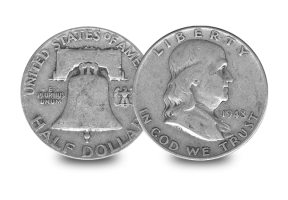
The Franklin Half Dollar was designed by John R. Sinnock and his ‘JS’ initials were again seen by conspiracy theorists as a tribute to Joseph Stalin.
In addition, the crack on the Liberty Bell was controversial, some people saw it as a statement that Liberty in the United States was under threat (despite the fact that the image exactly reflects the bell’s appearance).
Finally, what appears to be a small ‘o’ and large ‘F’ on the reverse (‘oF’ in the United States of America) was rumoured to be a mistake and that the Mint would recall all 1948 coins to correct the ‘error’.
Anthony Dollar (1979)
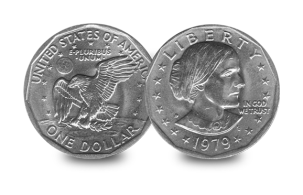
The Anthony Dollar was revolutionary – the first circulating coin to feature a historical woman. Susan B. Anthony was an author and protest speaker among other titles but best known as President of the National American Suffrage Association. The coin was also the first small-sized Dollar that was issued for wide circulation.
However, it quickly became notorious – and almost universally rejected – because it was the same colour and about the same size as a quarter. Therefore, it was often mistaken for a Quarter, and the public refused to use it! (Interestingly, it is now a sought-after collector’s item.)
For me, one of the best things about coin collecting is the story behind the coin and I’m sure you’ll agree that these coins from America have some truly fascinating stories to tell.
Discover the coins from the USA
Today you can secure for your collection the coins your fellow American Change Checkers are collecting, from 1 cent to 1 dollar!
Your guide to Guernsey’s rarest coins in circulation… Mintage figures revealed!
Coins from Crown dependencies and overseas British territories can sometimes make an unexpected appearance in our change.
They are identical in size, shape and weight to UK denominations (bar the new 12 sided £1) which means they often find their way into tills and vending machines undetected.
Finding one in your change can be an annoyance on one hand as technically the coins are not legal tender in the UK. On the other hand, from a collecting point of view, new and interesting designs are always a bonus!
Mintage figures for British Isles coins are very hard to track down, but we’ve managed to get hold of the definitive mintage figures for Guernsey to show you which are the rarest coins you should be looking out for.
Guernsey Definitive 50p Coin Mintage Figures

* These figures have been compiled from historic records in order to provide information to persons who inquire from time to time. All figures are provided as a matter of interest only and for no other purpose. It must be distinctly understood that the States of Guernsey nor its employees can accept responsibility for the accuracy of the figures or for the consequences of any errors or omissions and these figures are supplied under that understanding. [States of Guernsey]
Guernsey’s Definitive 50p Coins
Two different definitive 50p designs have been issued on Guernsey coinage between 1969 and 2012 – the Ducal Cap and Freesia 50p coins.
The first 50p design released in Guernsey, the Ducal Cap, was issued six times between 1969 and 1984, with each coin having a mintage of 200,000.
The coin features an image of the Ducal Cap of the Duke of Normandy on the reverse and the Guernsey Coat of Arms on the obverse, which includes three lions instead of Queen Elizabeth II’s portrait. This makes the 50p particularly distinguishable.

Guernsey Ducal Cap 50p. Issued from 1969-1984
Whilst the Ducal Cap 50ps have a fairly high mintage figure considering the size of Guernsey’s population (just 62,307 as of 2018), the most common Guernsey 50p is actually the 1997 Freesia design with a mintage of 1,044,000.
The Freesia 50p features the Guernsey Freesia Flowers on the reverse and the portrait of Queen Elizabeth II on the obverse. There is also a small Guernsey Coat of Arms on the obverse of the coin, which acts like a Guernsey mint mark and makes the Guernsey 50p stand out when compared to typical UK 50p coins.

Guernsey Freesia Flowers 50p. Issued from 1985 – 2012
Mintage figures for the Freesia design vary considerably, with the rarest coin issued in 1987 actually only having a mintage of 5,000. Mintage figures for the UK Britannia 50p were also low in 1987, as this coin had a mintage of 88,659, whereas the definitive 50p is normally issued in the millions. However the Guernsey Freesia Flowers 50p is still over 17 times rarer than it’s UK counterpart for 1987.
The most common Guernsey 50p, the 1997 Freesia Flowers has a mintage of 1,044,000, however this is still lower than the rarest UK definitive 50p (2017 Royal Shield), which has a mintage of 1,800,000.
Guernsey Definitive £2 Coin Mintage Figures

Guernsey’s Definitive £2 Coin
The first definitive Guernsey £2 coin design was actually dated 1997, but was only included in brilliant uncirculated and proof coin sets.
It was in 1998 that the first of the Guernsey £2 coins were issued in to general circulation, featuring the definitive Flag design.

Guernsey Flag £2 Issued from 1998 – 2012
As the first year of issue for the first bi-metallic coin, you’d expect the mintage for this to be high, however only 150,000 of these coins were struck in 1998. This makes the 1998 £2 Guernsey’s most common definitive £2 in circulation, but when compared to the UK’s most common £2 (1998 Technology design) which had a mintage of 91,110,375, you realise just how rare these Guernsey coins really are!
This design has remained the same since its introduction, however the mintages figures for subsequent years were drastically lower, with the rarest coin being released in 2012 with a mintage of just 5,250. Comparatively, the UK’s definitive £2 coin (Technology design) issued in 2012 had a mintage of 3,900,000 – that’s over 700 times more than the definitive coins issued in Guernsey that year!
Although £2 coins were issued in Guernsey in 1991, 1993, 1994 and 1995, these were actually commemorative crown size coins, not issued for circulation and so we do not have these figures. At that time The Royal Mint manufactured Guernsey’s commemorative coins, creating a crown size denomination from the £2 coin.
Guernsey Definitive £1 Coin Mintage Figures

* These figures have been compiled from historic records in order to provide information to persons who inquire from time to time. All figures are provided as a matter of interest only and for no other purpose. It must be distinctly understood that the States of Guernsey nor its employees can accept responsibility for the accuracy of the figures or for the consequences of any errors or omissions and these figures are supplied under that understanding. [States of Guernsey]
Guernsey’s Definitive £1 Coins
Three different definitive £1 designs have been issued in Guernsey since 1981 – the Lily, HMS Crescent and Finance Motif.
As you can see from the chart above, the Finance Motif design issued from 1985 – 2012 has dramatically lower mintage figures and has been issued more frequently.
The coin features the finance motif on the reverse, but as with most Guernsey coins, it is the unusual obverse that makes it stand out. The obverse features the portrait of Her Majesty the Queen facing right, with a small Guernsey Coat of Arms on the left.

Guernsey Finance Motif £1. Issued from 1985-2012
In 1981, Guernsey issued the Lily £1. Similar to the Ducal Cap 50p, the Lily £1 features the Guernsey Coat of Arms on the obverse, which includes three lions instead of Queen Elizabeth II’s portrait. The reverse of the design features a lily flower, the national flower of Guernsey.
200,000 Guernsey Lily £1 coins were issued in 1981, making it the second most common £1 on Guernsey.

Guernsey Lily £1. Issued in 1981
In 1983, Guernsey issued the HMS Crescent £1.This coin also features the Guernsey Coat of Arms on the obverse, but the reverse features an engraving of the HMS Crescent by Robert Elderton.
This is the most common Guernsey £1, with a mintage of 267,000. But, compared to the most common UK £1 (2015 Royal Arms) which has a mintage of 129,616,985, mintage figures for the HMS Crescent £1 are incredibly low. Almost 500 times lower than the most common UK £1!

Guernsey HMS Crescent. Issued in 1983
Although the 1981 Lily and 1983 HMS Crescent designs were only issued for one year each, they both have much higher mintage figures than the Finance Motif issued prior to these designs.
In fact, if you were to add up the mintages for every year the Finance Motif was issued (bar an unusually high year in 2001) the figure would still be lower than the 1981 Lily and 1983 HMS Crescent coins.
The rarest Guernsey £1 is the 1990 Finance Motif, with a mintage of just 3,500. We know that British Isles mintage figures are much lower than the UK due to the smaller population, however when you compare this to the rarest UK £1 which is the 2011 Edinburgh £1 with a mintage of 935,000, the difference is staggering! In fact, Guernsey’s rarest £1 is actually more than 250 times rarer than the Edinburgh £1!
Lack of Demand for New Definitive Coins
From 2012 to present there have been no definitive coins released on Guernsey, and we must assume that this is due to the fact that there just isn’t the demand for them. As previously mentioned, the small population of just 62,307 means that there are less coins issued on the British Isles.
Has any Guernsey coinage found its way into your pocket and have you been lucky enough to find any of the rarer coins? Let us know in the comments below.
Start your Guernsey coin collection!

You can now order your very own coins from Guernsey to kick start your collection!
Secure the Ducal Cap 50p, Freesia Flowers 50p or Finance Motif £1 here >>



